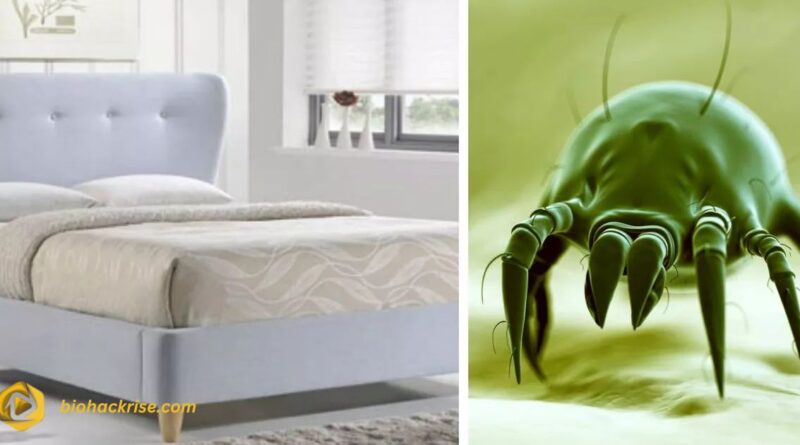Couch Mites: Hidden Invaders in Your Sofa and How to Get Rid of Them?
Couch mites are tiny, microscopic arthropods that often inhabit upholstered furniture, feeding on dead skin cells, dust and organic debris. They thrive in warm, humid environments and are commonly found in household fabrics like sofas, cushions and carpets.
These mites are not visible to the naked eye but can cause allergic reactions and skin irritation in sensitive individuals. While harmless in small numbers, their accumulation can lead to discomfort and hygiene concerns. Couch mites belong to the same family as dust mites, sharing similar living habits and lifecycles. Regular cleaning and humidity control help minimize their presence. Understanding their biology is essential for maintaining a clean, allergen-free living space.
Ever wondered what’s lurking deep inside your couch cushions? Those comfy seats might be home to thousands of invisible couch mites! Tiny but mighty, they thrive where you relax the most. Discover how these unseen invaders can affect your comfort and health.
Couch mites are nearly invisible creatures that live in sofas, feeding on skin flakes and dust. They multiply quickly in warm, damp conditions. Although they don’t bite, they can trigger allergies and asthma. Regular vacuuming and cleaning fabrics can help reduce their numbers.
What Are Couch Mites?
Couch mites are microscopic arachnids that thrive in fabric, upholstery and soft furnishings like sofas, cushions and carpets. They’re not a specific species called “couch mites” but rather a general term used for several types of mites that commonly inhabit couches such as dust mites, bird mites or even mold mites.
These tiny creatures feed primarily on organic debris such as dead skin cells, hair, pet dander and sometimes mold spores. Since your couch collects all these over time, it becomes an ideal breeding ground for mites.
Types of Mites Found on Couches
- Dust Mites – The most common type, thriving in humid environments and feeding on dead skin.
- Bird Mites – Often appear if there are bird nests near your home; they migrate indoors and infest furniture.
- Mold Mites – Live in damp environments and feed on mold growth in upholstery.
- Scabies Mites – Rare but dangerous; they burrow into human skin and cause severe itching and rashes.
How Do Couch Mites Get Into Your Home?
Couch mites usually enter your living space through infested items or environmental exposure. For instance, bringing in second-hand furniture or even sitting on public sofas can introduce them into your home. Pets can also carry mites in their fur, and airborne dust often brings dust mites into your upholstery naturally.
Once inside, these pests multiply quickly, especially if your home has high humidity or poor air circulation. They settle deep into fabric fibers, where they feed and reproduce unnoticed.
Signs You Might Have Couch Mites

Because they’re so tiny, couch mites aren’t visible to the naked eye. But there are several signs that can alert you to their presence:
- Unexplained itching or small red bites after sitting on the couch.
- Increased sneezing, coughing or nasal congestion due to mite droppings and skin flakes.
- Tiny white or beige specks visible on dark fabrics.
- Musty or moldy odor coming from the couch.
- Worsening allergy symptoms when lounging on or near furniture.
If you’ve noticed any of these symptoms, your couch might already be home to a growing mite population.
Are Couch Mites Dangerous?
Couch mites themselves don’t bite or transmit diseases like bed bugs, but their waste products and shed skins can trigger allergies, asthma and skin irritation. Prolonged exposure to their allergens can cause:
- Sneezing fits
- Coughing and wheezing
- Watery eyes
- Rashes or eczema flare-ups
In severe cases, people with dust mite allergies may develop chronic respiratory issues. So while couch mites aren’t deadly, they can seriously impact your comfort and health if left untreated.
How to Check for Couch Mites?
Detecting couch mites requires a bit of detective work. Here’s how you can find out if they’ve moved in:
- Inspect the Fabric: Use a magnifying glass to check seams, crevices, and cushion folds for tiny moving dots.
- Use a White Cloth Test: Gently tap or vacuum your couch over a white sheet. Tiny specks moving around are likely mites or their debris.
- Monitor Allergy Symptoms: If your allergies worsen when you sit on the sofa, that’s a strong indicator of dust mites.
- Try a Mite Detection Kit: These kits are available online and can identify the presence of mites through a simple test.
Effective Ways to Get Rid of Couch Mites
Getting rid of couch mites takes persistence and the right combination of cleaning and preventive tactics. Here’s a complete plan to reclaim your sofa:
1. Deep Clean Your Couch
Remove all cushions, covers and throws. Wash them in hot water (130°F / 54°C) to kill mites and their eggs. Use a steam cleaner on the couch fabric to eliminate those hiding deep inside.
2. Vacuum Thoroughly
Use a vacuum cleaner with a HEPA filter to capture even the smallest mite particles. Focus on crevices, corners and the underside of the sofa.
3. Use Natural Mite Repellents
Spray a mixture of tea tree oil, eucalyptus or lavender oil diluted in water onto your couch. These essential oils are natural acaricides that repel mites effectively without harming the fabric.
4. Reduce Humidity
Mites love moisture. Keep your indoor humidity below 50% using a dehumidifier or by running your air conditioner regularly.
5. Freeze Cushions
If possible, place smaller cushions in a sealed plastic bag and freeze them overnight. The extreme cold kills mites instantly.
6. Replace Old Upholstery
Sometimes, the infestation is too deep. If your couch is very old or heavily used, replacing the upholstery or even the entire sofa might be the best long-term solution.
Home Remedies to Eliminate Couch Mites Naturally?
If you prefer chemical-free solutions, several home remedies can help eliminate couch mites while keeping your living space safe for pets and family members. Here’s a list of effective natural treatments that really work:
1. Baking Soda and Essential Oils
Baking soda is a natural deodorizer that also helps dehydrate and kill mites. Mix 1 cup of baking soda with 10 drops of lavender or eucalyptus oil, sprinkle it evenly on the couch and leave it for an hour before vacuuming it thoroughly. The scent not only refreshes the fabric but also keeps mites away.
2. Vinegar Spray
A mixture of equal parts water and white vinegar is a powerful cleaning agent that kills bacteria, mold and mites. Spray it lightly on your couch and let it air-dry. Be cautious with delicate fabrics test a small area first to ensure it doesn’t cause discoloration.
3. Steam Cleaning
Steam is one of the most effective and eco-friendly ways to kill mites. The heat penetrates deeply into fabrics, killing mites and eggs on contact. Regular steam cleaning every few weeks can prevent reinfestation.
4. Lemon Juice and Clove Oil
Combine 2 cups of water, 1 tablespoon of lemon juice and a few drops of clove oil. Spray the mixture on your couch to create a pleasant aroma and an environment hostile to mites. The acidity and natural antiseptic properties destroy mite colonies while leaving your home smelling fresh.
RELATED POST: I Have to Sleep with a Stranger
Professional Treatments for Couch Mites
Sometimes, DIY cleaning isn’t enough, especially if the infestation is severe. In such cases, professional pest control services can provide deep and lasting relief.
Steam and Heat Treatments
Professionals often use high-temperature steam systems that kill mites instantly, reaching areas your home steamer can’t. These treatments are non-toxic and highly effective for upholstered furniture.
Chemical Treatments
When natural methods fail, specialized acaricides (mite-killing chemicals) can be applied by trained technicians. They use controlled quantities that are safe for home environments but lethal to mites.
Anti-Allergen Solutions
Professional cleaners can apply anti-allergen sprays that neutralize mite droppings and allergens, reducing respiratory irritation and allergy triggers.
Investing in professional treatment can seem costly upfront, but it often saves time, money and discomfort in the long run by completely eradicating the problem.
How to Prevent Couch Mites from Coming Back?
Getting rid of couch mites is one thing, but keeping them away is another. Prevention is key to maintaining a mite-free home. Here’s how to stop them from returning:
Regular Cleaning Habits
- Vacuum your couch weekly using a HEPA-filter vacuum.
- Wash removable cushion covers, throws, and blankets frequently in hot water.
- Wipe down non-fabric parts of your couch with an antibacterial cloth.
Maintain Low Humidity
Use a dehumidifier or air conditioner to keep indoor humidity below 50%. Mites thrive in moisture, so dry air discourages them from multiplying.
Air Out Your Furniture
Expose your couch to sunlight occasionally. UV rays are natural mite killers. If possible, take cushions outside for a few hours every month.
Use Anti-Mite Sprays or Covers
Apply a natural anti-mite spray or use specially designed dust-mite-proof covers for couches and cushions to prevent re-infestation.
Control Allergens
Limit dust buildup by using air purifiers and cleaning air vents regularly. The less dust, the fewer places mites have to hide and feed.
Difference Between Couch Mites and Bed Bugs
People often confuse couch mites with bed bugs because both cause itching and discomfort. However, they’re quite different:
| Feature | Couch Mites | Bed Bugs |
| Size | Microscopic (invisible to naked eye) | Visible (about the size of an apple seed) |
| Bites | Rare, usually cause allergies | Yes, leave red, itchy welts |
| Habitat | Sofas, upholstery, carpets | Mattresses, bed frames, cracks |
| Feeding Habits | Feed on dead skin and dust | Feed on human blood |
| Control Method | Deep cleaning, humidity control | Professional extermination |
Knowing the difference helps you apply the correct treatment and avoid wasting time or money on the wrong approach.
How to Treat Couch Mite Allergies?
If you or someone in your home is allergic to mites, managing symptoms is crucial alongside cleaning. Here’s what helps:
- Take antihistamines to control itching, sneezing, and watery eyes.
- Use nasal sprays or decongestants to relieve nasal blockage.
- Install a HEPA air purifier to remove allergens from the air.
- Keep your couch area clean and well-ventilated.
- See an allergist if symptoms persist, they can prescribe stronger medication or allergy shots.
Remember, treating the allergy alone won’t solve the issue, you must remove the source of mites to achieve lasting relief.
Why Couch Mites Love Your Sofa So Much
Your couch offers mites everything they need to thrive warmth, food and shelter. Think about it: you shed thousands of dead skin cells daily and many of them land right where you sit. Add pet dander, crumbs and moisture and you’ve created the perfect ecosystem for mites.
Mites also prefer dark, undisturbed areas like the underside of cushions or the spaces between fabric seams. That’s why they’re rarely visible and often go unnoticed until symptoms appear.
By understanding what attracts them, you can take specific actions to make your couch an unwelcoming place for them.
Best Fabrics to Avoid Couch Mite Infestations
Certain fabrics are more resistant to mites than others. If you’re considering reupholstering your furniture or buying a new couch, here are the best and worst materials in terms of mite resistance:
| Fabric Type | Mite Resistance | Notes |
| Leather | Excellent | Doesn’t trap dust or moisture, easy to wipe clean |
| Faux Leather | Very Good | Affordable alternative, similar benefits |
| Microfiber | Good | Dense weave limits mite penetration |
| Cotton or Linen | Poor | Absorbs moisture and traps dust |
| Velvet or Wool | Very Poor | Thick, textured fibers create perfect mite habitats |
Choosing the right upholstery can dramatically reduce mite problems in the future.
Myths and Misconceptions About Couch Mites
There’s a lot of misinformation floating around about couch mites. To effectively deal with them, it’s important to separate facts from fiction. Let’s debunk some of the most common myths:
Myth 1: Couch Mites Only Live in Dirty Homes
This is completely false. Couch mites can appear even in the cleanest homes because dust, skin flakes and humidity their main sources of sustenance are impossible to eliminate entirely. Regular cleaning helps reduce their numbers, but having mites doesn’t necessarily mean your home is dirty.
Myth 2: You Can Kill Mites Instantly with Air Fresheners or Sprays
Most air fresheners mask odors but don’t actually kill mites. Even many commercial sprays don’t reach deep enough into upholstery fibers to eliminate them. Real results require deep cleaning, steam treatment or high temperatures.
Myth 3: Mites Bite Humans Like Bed Bugs
Dust mites don’t bite. What feels like a bite is usually an allergic reaction to their waste particles or shed skins. If you have visible bite marks, you may be dealing with a different pest like fleas or bed bugs not dust mites.
Myth 4: Plastic Covers Solve the Problem Completely
While dust-proof covers help minimize exposure, they won’t kill existing mites inside your couch. You’ll still need to wash and clean your furniture thoroughly before covering it.
Myth 5: Mites Die Off Naturally in Winter
Mites can survive year-round in warm indoor environments. Even during winter, central heating creates the perfect cozy conditions for them to thrive. Only consistent cleaning and humidity control truly make a difference.
Understanding the truth about couch mites helps you take realistic steps to eliminate and prevent them effectively.
The Role of Pets in Couch Mite Infestations

Your furry friends may unknowingly contribute to the couch mite problem. Pets shed hair, dander and skin flakes all of which become food sources for mites. In addition, pets that go outdoors can bring in bird mites or other tiny pests in their fur.
How to Minimize Pet-Related Mite Issues
- Brush and bathe your pets regularly to reduce shedding.
- Use a pet-safe mite repellent spray on bedding and couches.
- Wash pet blankets and cushions in hot water weekly.
- Vacuum the couch immediately after your pets nap on it.
Maintaining pet hygiene and cleaning their favorite resting spots are vital steps in controlling mite populations at home.
Couch Mites and Indoor Air Quality
Couch mites not only affect your furniture but also the quality of air you breathe. Their feces and body fragments become airborne, circulating through your home. This can worsen allergies, asthma and respiratory issues.
To combat this, consider the following:
- Use air purifiers with HEPA filters to capture mite allergens.
- Change HVAC filters regularly to prevent allergen buildup.
- Vacuum floors and furniture with HEPA-filtered vacuums to trap fine dust.
- Open windows daily to allow fresh air exchange, lowering humidity and stale air.
Cleaner air means fewer allergens and a healthier home environment overall.
When to Call a Professional for Help?
Sometimes, even with diligent cleaning, mites can persist, especially if your home has structural issues like dampness or hidden mold. If you’ve tried all natural and DIY remedies without success, it’s time to bring in the professionals.
Professional pest control specialists can:
- Identify the exact type of mites infesting your couch.
- Apply targeted treatments that are safe and effective.
- Conduct follow-up inspections to ensure the problem is gone for good.
- Offer preventive maintenance tips tailored to your home’s condition.
You should call a professional if you notice persistent allergy symptoms, recurring infestations or visible signs of mold or dampness around your furniture.
How Often Should You Clean Your Couch to Avoid Mites?
Regular maintenance is key to keeping mites at bay. Experts recommend a monthly deep cleaning routine if you have allergies or pets and at least once every three months for low-use couches.
Your routine should include:
- Vacuuming every week.
- Steam cleaning or hot washing removable covers monthly.
- Spraying natural mite repellents every two weeks.
- Airing out cushions in direct sunlight occasionally.
By maintaining a consistent cleaning schedule, you can drastically reduce the chances of mites taking hold again.
Can Couch Mites Spread to Other Furniture?
Yes, unfortunately, mites can easily spread to other areas of your home. They’re light enough to be carried on dust particles, fabrics, or even your clothing. That’s why it’s essential to treat not just the couch, but also nearby carpets, curtains and soft furnishings when you notice signs of infestation.
A single untreated area can quickly lead to re-infestation. Always clean all fabric surfaces in your living space during a mite removal session.
Eco-Friendly Couch Mite Prevention Tips
If you’re conscious about sustainability and prefer green living, here are some eco-friendly ways to prevent mites:
- Use plant-based detergents free from harsh chemicals.
- Choose organic essential oils like eucalyptus or peppermint for cleaning.
- Opt for bamboo or cotton throws that can be washed easily.
- Avoid chemical sprays go for vinegar or lemon-based alternatives.
- Keep indoor plants like snake plants or peace lilies to purify air naturally.
Eco-friendly cleaning not only helps the environment but also creates a toxin-free space that’s healthier for your family.
FAQ’s
Can couch mites bite humans?
No, most couch mites don’t bite. However, their waste can cause allergic reactions that feel like bites or irritation on the skin.
How long do couch mites live?
A typical dust mite lives for around two to three months, during which it lays hundreds of eggs. Regular cleaning is essential to interrupt this cycle.
Can washing couch covers in cold water kill mites?
Cold water won’t kill mites. Always wash fabrics in hot water above 130°F (54°C) to ensure they’re eliminated.
How do I know if my couch has mites or bed bugs?
If you notice visible bugs or red bite marks, it’s likely bed bugs. If the symptoms are more like allergies and itching without visible pests, you’re dealing with dust or couch mites.
What’s the best natural way to prevent couch mites?
Use a mix of baking soda and essential oils, vacuum weekly and keep humidity low to make your home inhospitable to mites.
Conclusion
Couch mites might be invisible, but their impact is real from triggering allergies to making your favorite sofa less comfortable. The good news? With regular cleaning, humidity control, and preventive maintenance, you can easily reclaim your couch and your comfort.
Understanding what attracts mites, how they spread, and the best natural or professional solutions to eliminate them gives you the power to protect your home effectively. Remember, prevention is always easier than cure so don’t wait for itching or sneezing to start your mite-control routine.
Keep your home clean, your air fresh and your couch truly cozy again without those uninvited microscopic guests.




